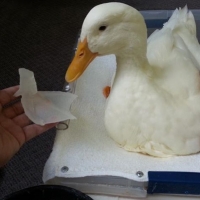Disabled Duck Walking Again with New 3D-Printed Foot

Buttercup is one lucky duck.
When he was hatched in a high school biology lab in November, his left foot was turned backward, making it difficult and painful for him to walk.
The little guy was moved to Feathered Angels Waterfowl Sanctuary in Arlington, Tennessee, where owner Mike Garey realized that due to the risk of infection from Buttercup’s deformity, the foot would have to be amputated.
Buttercup hobbled around on a peg leg for a while, but Garey, a software engineer, thought he could give him a better prosthetic. Garey found the answer in NovaCopy, a 3D-printing company that offered to create a foot for Buttercup and donate the model so he could waddle once more.
Using photos of Buttercup’s sister Minnie’s left foot, computer engineers were able to design a replica that would suit Buttercup. Now, the question was what material the foot should be made with. Normally, 3D printing uses plastic, but that would be too rigid for a duck’s foot. In recent medical procedures for humans, a biopolymer dust called polycaprolactone has been fused into custom parts, but those are designed to disintegrate over time.
NovaCopy decided to 3D print a mold instead and use it to cast a flexible, silicone foot for Buttercup. “The printing of his foot that I needed to make the mold took 13 and a half hours to print. So it's a pretty slow process,” Garey told a local Tennessee news outlet.
Three versions of the mold were printed—the first copy to verify scale, the second to increase the size of the leg so that Buttercup’s nub could fit inside, and the third version as the final draft, complete with Buttercup’s name printed in raised letters on the webbing.
The prosthetic was attached to his leg with a silicone sheath that rolled up the leg like a sock, with a nylon retaining screw in the bottom.
While all this was being planned, Buttercup became famous, with 10,129 fans on his Facebook page at the time of publication, along with numerous stories about his experience.
Sunday night, he was fitted with his brand-new foot for the first time, and Garey shared a video of the no-longer-lame duck waddling around on the prosthetic and quacking happily:
3D printing has been used to make toys, phone cases, and, yes, firearms. A new concept for a 3D-printed cast full of holes is also a popular idea gaining traction. But Buttercup’s story is one of the more heartwarming examples of this technology’s practicality.

